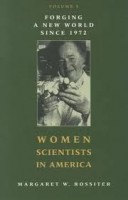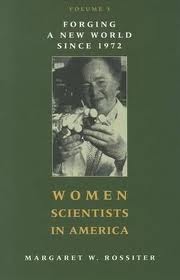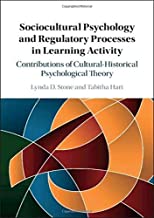 Author: Margaret W. Rossiter
Author: Margaret W. Rossiter
Publisher: Johns Hopkins University Press
Book Review by: Paiso Jamakar
On the cover of this book is chemist Gertrude Elion who won the 1988 Nobel Prize in Physiology or Medicine. She developed, along with a colleague, many important drugs. After winning the Prize she spoke about her early difficulties.
The current book, published in 2011, is Volume 3 on women scientists by Margaret W. Rossiter, who teaches the history of science at Cornell. Her two earlier books on this subject, whose titles are mentioned in her brief profile at the end of this book review, both won prizes for her pioneering work on a previously little-known subject.
Gertrude Elion is only one of just 44 women who have won any Nobel Prize since it was established in 1895. Comparatively, 807 men have won the Nobel Prize. For a total of 851 prizes that have been awarded since 1895, only five percent of them have been awarded to women. This may come as a shock to most readers, but it is true, and one can verify them on Wikipedia.
And of the 44 Nobel prizes received by women, only 17 have been in the field of science: ten for Physiology or Medicine, four for Chemistry, two for Physics and one for Economic Sciences. Women have done better however, in receiving other Nobel prizes than for any particular scientific endeavor. 15 have garnered the Nobel Peace and 12 have received the Nobel Prize for Literature.
These appallingly low numbers for women are but just one aspect of a widely spread phenomenon on the relatively low level of awards and rewards women in science have received in the worldwide male-dominated fields of physical sciences.
And that is what this book is all about. What makes it highly useful and inspiringly effective is that it is packed with eye-popping data obtained through surveys and research. For example, through more than 80 pages, the reader will find charts on the number of women that received bachelor’s and post-graduate degrees in the various sciences and in engineering in the 30-year period between 1970 and 2000.
Certainly, the charts show that the numbers of science degrees women received increase over the years, but very slowly. Overall, more than 160,000 women received science and engineering degrees in 2000, twice the number received 30 years earlier in 1970.
Data also abound in tables showing increasing numbers of women getting roles in science and engineering in education, government and professional organizations. In terms of faculty positions for example at the University of California-Berkeley, in the 1972-73 period, there were 29 women teaching science and engineering courses, or three percent of the total 948 academic positions in these areas. A decade later in the 1982-83 period, the number of women science and engineering instructors and professors by one and a half times from 29 to 74, but they were still only around seven percent of the total 1,005 faculty members in the various science and engineering departments at UC-Berkeley.
We surmise that the percentage of women faculty in science and engineering – not only at the university but also others throughout the United States – has grown, but no numbers for the nearly two decades since 1983 are available in this edition of the book that was published in 2011.
Margaret W. Rossiter points out in her Introduction that opportunities for women in general and women scientists in particular began to expand after the women’s liberation movement of the late 1960s and early 1970s. Two laws in particular helped women greatly. These were the passage in early 1972 of the Equal Employee Opportunities Act and the Education Amendments Act.
The increasing numbers of women students and faculty in the sciences and engineering that we have mentioned above were the result of the activism we witnessed in those two tumultuous decades.
This book has a fighting spirit with 12 gripping chapters. The reader will be absorbed by it. For example, chapters 1 and 2 entitled respectively: From “Sisterhood” to Interest Groups: Learning to Lobby, and Taking On Academia: Tokenism, “Revolving Doors” and Lawsuits to 1985.
I’m delighted to see so much valuable information in this wonderful book about the struggles and victories of women to realize their dreams and make contributions to society. The stories of their efforts to assert their rights not only in education and government but also in various businesses and industries are eye-opening and can probably not be found in other books. That is what makes this book rare and unique.
Margaret W. Rossiter is the Marie Underhill Noll Professor of the History of Science at Cornell University and former editor of Isis and Osiris. Her prize-winning books Women Scientists in America: Struggles and Strategies to 1940 and Women Scientists in America: Before Affirmative Action 1940-1972, are also published by Johns Hopkins. Professor Rossiter was a MacArthur Fellow from 1989 until 1994.







